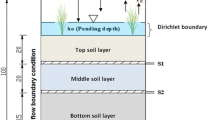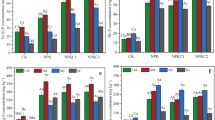Abstract
The micro paddy lysimeter (MPL) was developed and evaluated for its performance to simulate solute transport in paddy environment under laboratory conditions. MPLs were constructed using soil collected from Field Museum Honmachi of Tokyo University of Agriculture and Technology, Japan. For the physical characteristics of the hardpan layer, parameters such as thickness, and soil aggregate size, affecting the percolation rate were studied. For the plow layer, two types of plow soils, sieved and un-sieved soils were compared. The sieved soil plow layer was produced by mixing air-dried soils of different aggregate sizes of D > 9.50, 9.50 ≥ D > 4.75, 4.75 ≥ D > 2.0 mm and D ≤ 2.0 mm at 47.1, 19.5, 20.6, and 12.8%, respectively. The un-sieved plow layer soil was directly used after collecting from the field. Inert tracer was applied to ponding water with controlled boundary conditions to evaluate the reproducibility of the soil hydraulic characteristics. HYDRUS-1D was used to evaluate the movement of bromide tracer in the MPL. The proposed conditions of the MPL were that the hardpan layer can be made from soil aggregates smaller than 0.425 mm with 2 cm thickness and that the plow layer can be prepared with sieved or un-sieved soils. With these conditions, the obtained results proved that MPLs can be a useful tool to simulate solute transport in paddy environment.






Similar content being viewed by others
References
Adachi K (1992) Effect of puddling on rice-soil physics: softness of puddled soil and percolation. In: Murty VVN, Koga K (eds) Int workshop on soil and water engineer for paddy field management. Bangkok, Thailand, pp 220–231
Aimrun W, Amin MSM (2009) Pedo-transfer function for saturated hydraulic conductivity of lowland paddy soils. Paddy Water Environ 7:217–225
Aimrun W, Amin MSM, Eltaib SM (2004) Effective porosity of paddy soils as an estimation of its saturated hydraulic conductivity. Geoderma 121:197–203
Arora VK, Gajri PR, Uppal HS (2006) Puddling, irrigation, and transplanting—time effects on productivity of rice—wheat system on a sandy loam soil of Punjab, India. Soil Till Res 85:212–220
Begin L, Fortin J, Caron J (2003) Evaluation of the fluoride retardation factor in unsaturated and undisturbed soil columns. Soil Sci Soc Am J 67:1635–1646
Brooks SC, Taylor DL, Jardine PM (1998) Thermodynamics of bromide exchange on ferrihydrite: implications for bromide transport. Soil Sci Soc Am J 62:1275–1279
Chen SK, Liu CW, Huang HC (2002) Analysis of water movement in paddy rice fields (II) simulation studies. J Hydrol 268:259–271
Clay DE, Zheng Z, Liu Z, Clay SA, Trooien TP (2004) Bromide and nitrate movement through undisturbed soil columns. Environ Qual 33:338–342
Dousset S, Thevenot M, Pot V, Simunek J, Andreux F (2007) Evaluating equilibrium and non-equilibrium transport of bromide and isoproturon in disturbed and undisturbed soil columns. J Contam Hydrol 94:261–276
Ghosh BC, Bhat R (1998) Environmental hazards of nitrogen loading in wetland rice fields. Environ Pollut 102:123–126
Hasegawa S, Warkentin B (2006) The changing understanding of physical properties of soils: water flow and soil architecture. In: Warkentin B (ed) Footprints in the soil: people and ideas in soil history. Elsevier, Amsterdam, pp 340–341
Humphreys E, Muirhead WA, Fawcett BJ (1992) The effect of puddling and compaction on deep percolation and rice yield in temperate Australia. In: Murty VVN, Koga K (eds) International workshop on soil and water engineer for paddy field management, Bangkok, Thailand, pp 212–219
Ishiguro M, Song KC, Yuita K (1992) Ion-transport in an allophanic andisol under the influence of variable charge. Soil Sci Soc Am J 56:1789–1793
Jester WA, Uhler KA (1974) Identification and evaluation of water tracers amenable to post-sampling neutron activation analysis. Pennsylvania State University, Research publication 85, 92 pp
Koga K (1991) Soil compaction in agricultural land development. Asian Institute of Technology
Kohno E, Ogawa Y, Iwata S (1995) Productivity of paddy fields. In: Tabuchi T, Hasegawa S (eds) Paddy fields in the world. JSIDRE, Tokyo, pp 341–349
Kukal SS, Aggarwal GC (2002) Percolation losses of water in relation to puddling intensity and depth in a sandy loam rice (Oryza sativa) field. Agric Water Manag 57:49–59
Kukal SS, Aggarwal GC (2003) Puddling depth and intensity effects in rice-wheat system on a sandy loam soil I. Development of subsurface compaction. Soil Till Res 72:1–8
Leap DI (1992) Apparent relative retardation of tritium and bromide in dolomite. Ground Water 30:549–558
Lennartz B, Kamra SK (1998) Temporal variability of solute transport under vadose zone conditions. J Hydrol Process 12:1939–1949
Liu CW, Chen SK, Jou SW, Kuo SF (2001) Estimation of the infiltration rate of a paddy field in Yun-Lin, Taiwan. Agric Syst 68:41–54
Liu CW, Cheng SW, Yu WS, Chen SK (2003) Water infiltration rate in cracked paddy soil. Geoderma 117:169–181
Liu CW, Yu WS, Chen WT, Chen SK (2005) Laboratory investigation of plough sole reformation in a simulated paddy field. J Irrig Drain Eng ASCE 131(5):466–473
Loague K, Green RE (1991) Statistical and graphical methods for evaluating solute transport models: overview and application. J Contam Hydrol 7:51–73
MAFF (1996) Planning report of land improvement project—the east of Lake Biwa Area. In: Ministry of Agriculture Forestry and Fisheries (in Japanese)
Maie N, Watanabe A, Kimura M (2004) Chemical characteristics and potential source of fulvic acids leached from the plow layer of paddy soil. Geoderma 120:309–323
Mallawatantri AP, McConkey BG, Mulla DJ (1996) Characterization of pesticide sorption and degradation in macropore linings and soil horizons of Thatuna silt loam. J Environ Qual 25:227–235
Malone RW, Bonta JV, Stewardson DJ, Nelsen T (2000) Error analysis and quality improvement of the Coshocton weighing lysimeters. Trans Am Soc Agric Eng 43:271–280
Marquardt DW (1963) An algorithm for least-squares estimation of nonlinear parameters. J Soc Ind Appl Math 11:431–441
Maru S (1990) Outflow of pesticides from a paddy lysimeter as affected by the water solubility. J Pestic Sci 15:385–394
McDonald AJ, Riha SJ, Duxbury JM, Steenhuis TS, Lauren JG (2006) Water balance and rice growth responses to direct seeding, deep tillage, and landscape placement: findings from a valley terrace in Nepal. Field Crops Res 95:367–382
Meissner R, Seeger J, Rupp H, Schonert P (1999) Estimating the effects of set-aside on water quality: scaling-up of lysimeter studies. Land Degrad Dev 10:13–20
Melamed R, Jurinak JJ, Dudley LM (1994) Anion exclusion-pore water velocity interaction affecting transport of bromine through an oxisol. Soil Sci Soc Am J 58:1405–1410
Mousavi SF, Yousefi-Moghadam S, Mostafazadeh-Fard B, Hemmat A, Yazdani MR (2009) Effect of puddling intensity on physical properties of a silty clay soil under laboratory and field conditions. Paddy Water Environ 7:45–54
Nhung DTT, Phong TK, Watanabe H, Iwafune T, Thuyet DQ (2009) Simulating the dissipation of two herbicides using micro paddy lysimeters. Chemosphere 77:1393–1399
Osari (1988) Analysis of stirred and compacted operation on puddling by a tractor. Trans Jpn Soc Irrig Drain Reclam Eng 134:1–7 (in Japanese)
Owens LB, Malone RW, Shipitalo MJ, Edwards WM, Bonta JV (2000) Lysimeter study of nitrate leaching from a corn-soybean rotation. Environ Qual 29:467–474
Payne BR (1988) The status of isotope hydrology today. J Hydrol 100:207–237
Reber LA, McNabb WM (1937) Determination of chlorides and bromides. Ind Eng Chem Anal Ed 9(11):529
Sanchez P (1973) Puddling tropical rice soils II. Effects of water losses. Soil Sci 115:303–308
Schmotzer J (1973) Groundwater tracing with post sampling activation analysis. J Hydrol 20:217–236
Seaman JC, Bertsch PM, Miller WP (1995) Ionic tracer movement through highly weathered sediments. J Contam Hydrol 20:127–143
Simunek J, Van Genuchten MT (2008) Modeling nonequilibrium flow and transport processes using HYDRUS. Vadose Zone J 7:782–797
Simunek J, Sejna M, Saito H, Sakai M, Van Genuchten MT (2008) The Hydrus-1D Software package for simulating the movement of water, heat, and multiple solutes in variably saturated media, version 4.0, HYDRUS software series 3. Department of Environmental Sciences, University of California Riverside, USA, p 315
Singh KB, Gajri PR, Arora VK (2001) Modelling the effects of soil and water management practices on the water balance and performance of rice. Agric Water Manag 49:77–95
Tanaka H, Nakamura Y, Motobayashi T (2008) The detailed soil map of paddy field located in field museum Honmachi, Tokyo University of Agriculture and Technology. J Field Sci 7:1–10 (in Japanese)
Tennyson LC, Seltergren CD (1980) Percolate water and bromide movement in the root zone of effluent irrigation sites. Water Resour Bull 16:433–437
Tournebize J, Watanabe H, Takagi K, Nishimura T (2006) The development of a coupled model (PCPF-SWMS) to simulate water flow and pollutant transport in Japanese paddy fields. Paddy Water Environ 4:39–51
Watanabe H (2008) Pesticide exposure assessment in rice paddy areas: an Asian perspective. In: Capri E, Karpouza D et al (eds) Pesticide risk assessment in rice paddies: theory and practice. Elsevier, Amsterdam, pp 167–211
Watanabe H et al (2007) Effect of water management practice on pesticide behavior in paddy water. Agric Water Manag 88:132–140
West G, Dumbleton MJ (1975) Wet sieving for the particle-size distribution of soils: 1F, 3T, 10R Transport, Road research Lab. Report, LR437, 1972, 10P. Int J Rock Mech Mining Sci Geomech Abstr 12:88–88
Wierenga PJ, Vangenuchten MT (1989) Solute transport through small and large unsaturated soil columns. Ground Water 27:35–42
Wopereis MCS, Wosten JHM, Bouma J, Woodhead T (1992) Hydraulic resistance in puddled rice soils—measurement and effects on water-movement. Soil Till Res 24:199–209
Wopereis MCS, Bouman BAM, Kropff MJ, Tenberge HFM, Maligaya AR (1994) Water-use efficiency of flooded rice fields. 1. Validation of the soil-water balance model Sawah. Agric Water Manag 26:277–289
Acknowledgments
The authors are indebted to Dr. Takashi Motobayashi at FM Honmachi at Tokyo University of Agriculture and Technology for arranging field experiment site. Thanks are also due to Dr. Makoto Kato at NTC consulting company Ltd., Tokyo, Japan for providing technical assistance for this study.
Author information
Authors and Affiliations
Corresponding author
Rights and permissions
About this article
Cite this article
Thuyet, D.Q., Hien, T.Q., Watanabe, H. et al. Micro paddy lysimeter for monitoring solute transport in paddy environment. Paddy Water Environ 8, 235–245 (2010). https://doi.org/10.1007/s10333-010-0204-8
Received:
Revised:
Accepted:
Published:
Issue Date:
DOI: https://doi.org/10.1007/s10333-010-0204-8




